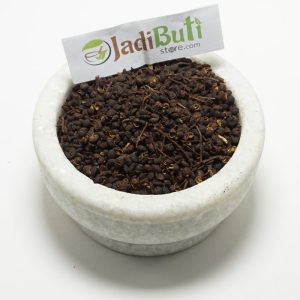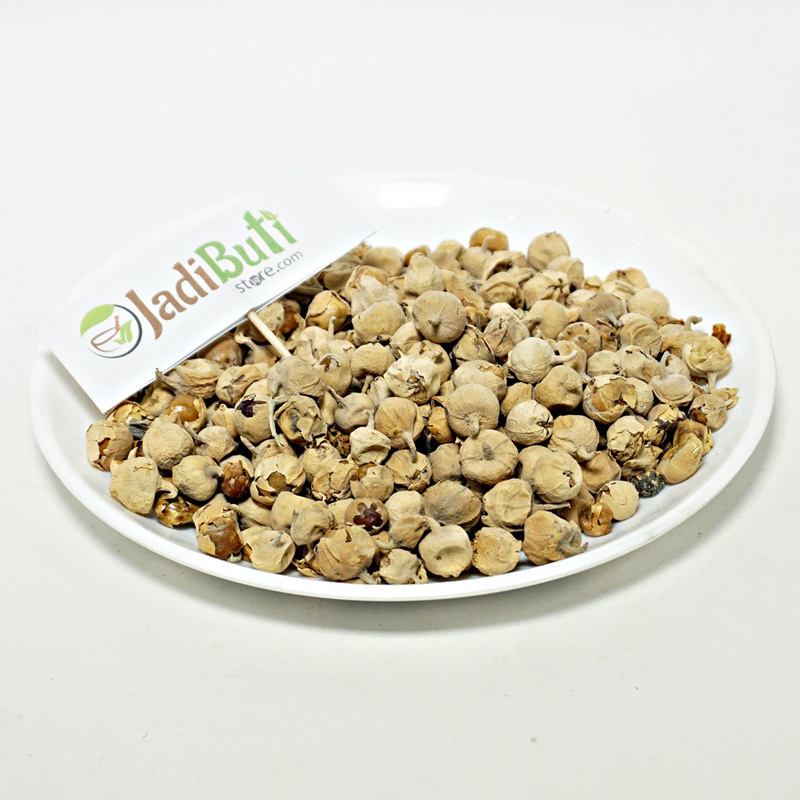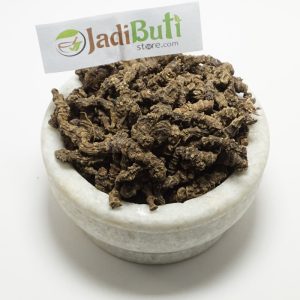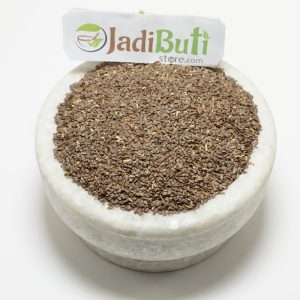T
Showing 13–24 of 26 results
-


Kabab khanda – कबाब खंदा – Toothache Tree – Zanthoxylum armatum
₹260.00 – ₹1,990.00Quick ViewKabab khanda – कबाब खंदा – Toothache Tree – Zanthoxylum armatum.
Kabab khanda in English name – Toothache Tree
Kabab khanda in Hindi name – Tumbru
Kabab khanda in Latin name – Zanthoxylum armatum
- Analgesic properties: The fruit of Zanthoxylum armatum is known for its ability to relieve toothache and other types of pain.
- Anti-inflammatory: The fruit is also considered to have anti-inflammatory properties, making it useful for reducing swelling and redness.
- Pungent flavor: The fruit is used as a spice and is known for its strong, pungent flavor.
- Traditional use: In traditional Ayurvedic medicine, the fruit of Zanthoxylum armatum has been used for centuries to treat various ailments.
- Hard texture: The fruit has a hard texture and is often ground into a powder for use as a spice or for medicinal purposes.
-


Methi Dana (Organic) – मेथी दाना – Fenugreek Seeds – Trigonella foenum-graecum
₹110.00 – ₹850.00Quick ViewMethi Dana – मेथी दाना – Fenugreek Seeds – Trigonella foenum-graecum.
Methi Name In Different Languages:
Methi in English Name : Fenugreek, Bird’s Foot, Greek Hayseed
Methi in Hindi Name : Methi
Methi in Latin name : Trigonella foenum-graecum Linn.
Methi in Urdu Name : Methi, Tukhme Hulba
Methi in Arabic Name : Hulba, Fareeqa
Methi in Bengali Name : Methi
Methi in Chinese Name : Hu lu ba
Methi in French Name : Fenugrec sénegré
Methi in German Name : Bockshornklee, Kuhhornklee, Griechisch-Heu
Methi in Gujarati Name : Methi
Methi in Kannada Name : Menthya
Methi in Kashmiri Name : Meeth
Methi in Marathi Name : Methi
Methi in Persian Name : Shamleez
Methi in Punjabi Name : Methi
Methi in Sanskrit Name : Methika, Methini
Introduction:
Fenugreek is cultivated in almost all the states. Vegetables are made from fenugreek leaves. Its seeds are used in a variety of dishes for diet and as a medicine. Flowers and fruits of fenugreek are found in the months of January to March. Fenugreek plants are one feet high. Its leaves are small and round-shaped. Fenugreek seeds are called fenugreek seeds. It is also found in the Jagannis. Fenugreek found in forests is of low quality. Vegetables of fenugreek granules are made in Rajasthan, besides the vegetables, fodder leaves are made from Dhokles, Mithai and Gotas. Some people make mixed greens of mung and fenugreek seeds. Apart from this, pickle of raw mango and mixing fenugreek and other spices are prepared in it. This pickle is delicious and quality. In winter, fenugreek is consumed mostly in most of the houses.
-


Paneer Doda – Tukme Hayat – Paneer Dodi – Withania Coagulans
₹110.00 – ₹825.00Quick ViewPaneer Doda | Paneer Dodi | Withania Coagulans.
Ayurvedic classification of Paneer Dodi (Withania coagulans):
Ayurvedic Classification Description Rasa (taste) Bitter, astringent, and sweet Guna (qualities) Light, dry, and sharp Virya (potency) Heating Vipaka (post-digestive effect) Sweet Dosha effect Pacifies Kapha and Vata doshas Karma (actions) Digestive, anti-inflammatory, anti-diabetic, immune-modulating, and anti-cancer Dhatu (tissue) affinity Works primarily on the digestive and respiratory tissues Srotas (channel) affinity Works primarily on the digestive and respiratory channels Prabhava (special effect) Helps to regulate blood sugar levels Active compounds and benefits of Paneer Dodi (Withania coagulans):
Active Compound Benefits Withanolides Anti-inflammatory, anti-cancer, immune-boosting, and adaptogenic properties Withaferin A Anti-inflammatory, anti-cancer, neuroprotective, and cardioprotective properties Coagulin Hypoglycemic, antidiabetic, and lipid-lowering properties Steroids (β-sitosterol, stigmasterol, and campesterol) Anti-inflammatory, antioxidant, and immune-boosting properties Flavonoids (luteolin, apigenin, and kaempferol) Antioxidant, anti-inflammatory, and anti-cancer properties -


Punarnava – पुनर्नवा – Tarvine – boerhavia diffusa
₹110.00 – ₹875.00Quick ViewName: Punarnava | Scientific Name: Boerhavia diffusa
Other Names: Spreading Hogweed, Tarvine
Properties Description Rasa (Taste) Bitter, Astringent, Sweet Virya (Energy) Cooling Vipaka Sweet Guna (Quality) Light, Dry Health Benefits:
- Kidney Health: Punarnava is considered a potent diuretic in Ayurveda, and it may help improve kidney function and treat conditions like nephritis and urinary tract infections.
- Anti-inflammatory Properties: Punarnava has anti-inflammatory properties and may help reduce inflammation and pain in conditions like arthritis and gout.
- Liver Health: Punarnava is considered a liver tonic in Ayurveda, and it may help improve liver function and treat conditions like jaundice and hepatitis.
- Respiratory Health: Punarnava is used in Ayurveda to treat respiratory conditions like asthma, bronchitis, and coughs.
- Heart Health: Punarnava is used in Ayurveda to treat cardiovascular conditions like high blood pressure and heart disease.
- Anti-aging: Punarnava is known as a “rejuvenating” herb in Ayurveda, and it may help slow down the aging process.
Parts Used: Roots
-


Safed Til – सफ़ेद तिल – WHITE SESAME SEEDS – SESAMUM INDICUM
₹120.00 – ₹890.00Quick ViewSafed Til – सफ़ेद तिल – WHITE SESAME SEEDS – SESAMUM INDICUM
Mostly, sesame is used with food in the winter season. There are three kinds of sesame according to color as- white, red and black. Mostly, black sesame is used in the medicines. Sesame and sugar are used to make rebri. It is grown in enough quantity in India. Sesame can be grown alone or with crop of cotton or cattail or myrabalan chebulie or groundnut. India is excellent place to grow sesame.
Sesame oil: Sesame oil is heavy, wet and warm in nature. It increases body strength, memory power, Wellness power and appetite. It helps in stool clearly and improves the skin color. It cleans and purifies the uterus. It normalizes vatta, pitta and kahpa. It is useful for the treatment of blood disorders caused by bile, diabetes, ears pain, Vulva pain and headache.
Name in different languages:
English : Gingeli sesame
Hindi : Til, Tilli ka tel
Sanskrit : Til, Tilli ka tel
Gujarati : Tal, Bheethu tel
Marathi : Til, Gouda tel
Bengali : Til
Parsian : Kunjand, Rogan kunjand
Arab : Sheeraj, Simsim, Samsam, Hul
Scientists : Setumun orintel
Color: white
Taste: Its juice is bitter, sweet, pungent and spicy.
Structure: One year’s plant of sesame is soft and hairy. Its tree is about 15-36 inches high. Its leaves’ upper part is simple, rectangle and in garland shape. Its leaves’ front part has lines and middle part is conical. Its leaves sides are divided in many parts like teeth. Its flowers are one and half inches long, purple, white and with yellow marks. Its pods are 2 inches long, quartern and front part is blunted.
Nature: Sesame is heavy, hot in nature and smooth. The light yellow liquid, which is extracted from sesame, is called sesame oil or sweet oil. Its offensive smell is interested. Its oil contains protein elements. Its seeds contain sisemolin, simemia, lypage, pradhanta, oitic, nicotinic acid, pamitic and linolic acid. Its seeds also contain styaric and glysraidus of arecidic acid in less quantity.
Precaution: Pregnant woman should not take sesame because it is very harmful for her.
-


Sarphokha – सरफोखा – Purple Tephrosia – Tephrosia purpurea
₹190.00 – ₹1,455.00Quick ViewSarphoka (Tephrosia purpurea):
Common Name: Sarphoka, wild indigo, purple tephrosia, fish poison plant
Scientific Name: Tephrosia purpurea
Family: Fabaceae
Parts Used: Whole plant, roots, leaves, seeds
Ayurvedic Properties:
- Rasa (taste): Bitter (tikta), Pungent (katu)
- Virya (energy): Hot (ushna)
- Vipaka (post-digestive effect): Pungent (katu)
- Doshas (constitutions): Pacifies Kapha and Pitta
Health Benefits:
- Digestive health
- Respiratory health
- Skin health
- Liver health
- Anti-inflammatory and analgesic properties
- Anti-cancer properties (preliminary research)
Note: Sarphoka should be used under the guidance of a qualified Ayurvedic practitioner. It is not recommended for pregnant or lactating women and should be used with caution in individuals with liver or kidney disease.
-


Tagar – तगर – Sugandh bala – Valeriana wallichii DC
₹190.00 – ₹1,495.00Quick ViewTagar – तगर – Sugandh bala – Valeriana wallichii DC.
Tagar Name in different languages:
Tagar in English Name : Indian Valerian
Tagar in Hindi Name : Tagar, Sugandh Bala, Mushkbala, Bala Tagra
Tagar in Latin name : Valeriana wallichii DC
Tagar in Urdu Name : Asaroon
Tagar in Arabic Name : Asaaroon
Tagar in Bengali Name : Asaroon, Tagar Paduka, Asaroon, Mushkbala, Shumeo
Tagar in French Name : Valériane lndienne
Tagar in German Name : Indischer Baldrian
Tagar in Gujarati Name : Tagar Ganthoda
Tagar in Kannada Name : Mandibattal, Mandyavanthu, Mandibattalu, Tagar
Tagar in Kashmiri Name : Bala, Mushkbala, Chhalgudi
Tagar in Marathi Name : Tagar Ganthoda, Tagarmool
Tagar in Persian Name : Shanadar
Tagar in Punjabi Name : Muskwali, Balmudak
Tagar in Sanskrit Name : Tagara, Tagaraka, Nata, Chakra
-


Talmakhana – तालमखाना – Hygrophilia – Astercantha Longifolia
₹160.00 – ₹1,225.00Quick ViewTalmakhana – तालमखाना – Hygrophilia – Astercantha Longifolia.
Name in different languages:
Talmakhana in English Name : Hygrophilia
Talmakhana in Hindi Name : Talmakhana, Gokulakanta
Talmakhana in Latin name : Hygrophila spinosa T. Anders
Talmakhana in Urdu Name : Talmakhana
Talmakhana in Bengali Name : Kuliyakhara, Kulekhad, Shrigali
Talmakhana in German Name : Langblattriger Sterndorn
Talmakhana in Gujarati Name : Ekharo
Talmakhana in Kannada Name : Kolavali, Kolarind, Kolavankal
Talmakhana in Kashmiri Name : Talmakhana, Talimakhana
Talmakhana in Marathi Name : Talikhana, Kolsunda
Talmakhana in Punjabi Name : Talmakhana, Talimakhana
Talmakhana in Sanskrit Name : Kokilaksha, Ikshura
-


Tarbooj Beej – तरबूज बीज – Watermelon Seeds – Tarbooj Magaz
₹90.00 – ₹690.00Quick ViewTarbooj Beej (Watermelon Seeds)
Scientific name: Citrullus lanatus
Ayurvedic properties:
- Rasa (taste): Sweet, astringent
- Virya (energy): Cooling
- Vipaka (post-digestive effect): Sweet
- Guna (qualities): Light, dry
- Doshas (effect on humors): Pacifies Pitta dosha, may aggravate Kapha dosha in excess
Health benefits:
- Promotes kidney health
- Improves digestion
- Supports cardiovascular health
- Boosts immune system
- Enhances Physical health
- Promotes skin health
- Helps manage diabetes
- Supports bone health
- Reduces inflammation
- Aids in weight loss
- Promotes eye health
- Boosts energy and stamina
Precautions and contraindications:
- Excess consumption may aggravate Kapha dosha
- May cause digestive discomfort in some individuals
- Consult a qualified Ayurvedic practitioner before use
-


Til Kala (Organic Dry) – काला तिल – Sesame Seeds – Sesamum Indicum
₹90.00 – ₹690.00Quick ViewBlack sesame seeds are small, Dry seeds that are commonly used in traditional Ayurvedic medicine. These nutrient-dense seeds are an excellent source of protein, fiber, healthy fats, and various vitamins and minerals, including calcium, magnesium, and iron.
In Ayurveda, black sesame seeds are considered a potent rejuvenating food that can help improve vitality and overall health. They are believed to help balance the doshas, particularly Vata and Pitta, and are often recommended for conditions such as constipation, dry skin, and hair loss.
-


Tukmaria Sabja Seeds – तुकमारिआ मोटा – Ocimum Basilicum – Tukhmishra
₹110.00 – ₹875.00Quick ViewSabja Seeds (Tukmaria or Basil Seeds)
Scientific name : Ocimum Basilicum
Ayurvedic Properties:
Property Description Rasa (taste) Sweet, Bitter Virya (energy) Cooling Vipaka Sweet Guna (quality) Light, Dry Dosha Balances Pitta and Kapha, aggravates Vata
.Active Compounds Benefits Omega-3 fatty acids Reduces inflammation, supports heart health Fiber Promotes digestive health, helps control appetite Flavonoids Anti-inflammatory, antioxidant, and anticancer properties Calcium Supports bone health, muscle function, and nerve transmission Iron Helps prevent anemia, supports immune system Magnesium Helps regulate blood sugar and blood pressure, supports nerve and muscle function Potassium Helps regulate fluid balance, supports heart health


